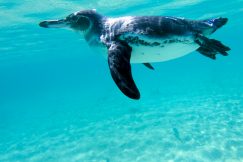Penguins can hold their breath for up to 20 minutes at a time. Penguins are great swimmers and spend their lives in the open ocean hunting underwater.
Can Penguins Breathe Underwater?

Unlike fish – birds cannot breathe underwater. Birds – like mammals – breathe air and haven’t yet evolved a way to breathe underwater. Even though penguins and other seabirds spend their lives at sea catching fish, jellyfish, krill, and other aquatic life – they still need to return to the surface to inhale air.
However, they do have special adaptations that allow them to do this for longer than other birds. Penguins have taken to actually living in the ocean – rather than just flying into to catch fish or simply floating on the top. To do this they have evolved many specialist body-parts:
Streamlined bodies: Penguins have changed shape to be more hydrodynamic – torpedo-shaped
Specialist feathers: Penguins feathers are short and mobile – allowing them to trap air and stay warm
Solid bones: Unlike other birds that have hollow bones to fly – penguins have heavy bones to help them sink?
Swimming goggles: Penguin’s eyes have a protective layer to help them see more clearly underwater
Pockets of air; Birds bodies have air sacs as well as lungs so can hold more air when needed
Clever circulation: Penguins can re-direct heat in the body away from skin to help keep the blood warm during deep dives
All in all – penguins swimming, diving and feeding in cold water and at great depth – have everything they need already onboard.
How Long Can Penguins Stay Underwater?

With all these adaptations – how long can penguins stay underwater on average? Well, the answer for average dives is not really much longer than a human. Sorry.
Most penguins don’t really dive for more than a minute or two at a time – because most can feed at the surface as this is where their food is. On an average day when food is plentiful – they just dip up and down – feeding freely.
However there are times when they need to go deeper and for longer.
Larger penguins such as the Emperor and King penguins (both around 1m tall) feed on food that tends to live lower in the water column and so deeper dives are essential. Once they find a patch of food they can go up and down directly to the source. However, in times of difficulty or hunger – they have been recorded underwater for over 27 minutes in one single dive! Wow. They have also been found at around 550m deep too by scientists.
Other penguins such as Gentoo and Yellow-Eyed penguins are often seen feeding on the ocean floor – feasting on crustaceans. Depending on their environment this extends dive times somewhat – and isn’t seen at all in other locations. These recordings show how varied penguins can be in their survival techniques.
Can Hippos Stay Underwater for Long Periods of Time?
Hippos’ ability to breathe underwater is extraordinary. These massive creatures can hold their breath for up to five minutes while submerged. With adaptations such as nostrils located high on their heads, they can almost completely submerge themselves and still take in air. This unique adaptation allows hippos to spend a considerable amount of time beneath the water’s surface.
Can Penguins Drown?

Penguins are so adept at their watery lives that drowning under normal conditions is extremely unlikely. Even during the worst weather, they are equipped to cope with giant waves, heavy rain, and icy-cold water.
They can hold their breath incredibly effectively – and like most sea mammals – can find shelter in places that would seem unlikely to save a human. Penguins also have a thick layer of blubber to keep them warm in the worst of places – and unless there are predators better at it than they are – they can ride out most storms.
Due to the way that they can leap out of the water onto land several feet above the water’s surface – they could hop out anywhere too. Jumping onto land is easy – but they can also easily leap out onto floating ice sheets and huge icebergs if needed. These temporary platforms can often put them at greater risk than finding solid ground though because predators could be circling – but sometimes these are their only option.
If, however, they became injured or trapped by fishing equipment or litter in the ocean – then all their adaptations could fail them. Accidental death at the hands of humans is one of the biggest killers of ocean wildlife. And as there is a huge amount of litter in the oceans – this is becoming more and more of a problem for seabirds like penguins.









